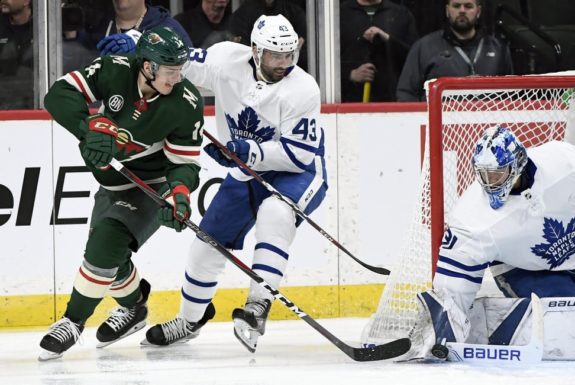
On Jan. 7, 2019, something very special happened when the Toronto Maple Leafs played the Nashville Predators. Two old friends played against each other. No doubt, that’s happened many times in the NHL. However, what makes this meeting so special is the humble circumstances and difficult beginnings of these young NHL players.
Both grew up in the northern Swedish rural town (population 441) of Kusmark. There’s a school in the town, which also was the hockey rink. Par Lindholm, the son of a local dairy farmer, and Viktor Arvidsson, the son of a potato farmer, often met there to play pick-up hockey like many children do all over the world.
For the tiny town of Kusmark, it’s significant that two of its sons would meet at Scotiabank Arena so far from home. Until Arvidsson played with Nashville in 2015, the town had never developed an NHL player. And when Lindholm signed a free-agent contract with the Maple Leafs last summer, Kusmark had two NHL players.

As Arvidsson said, “It’s like pretty surreal that it happened. It’s good for the little village at home, they’re proud of us.” Nashville chose Arvidsson during the fourth round of the 2014 NHL Draft, and he’s turned into a 30-goal, 60-point player. Perhaps Lindholm will have similar success. But it sure didn’t look that way at the beginning. Lindholm wasn’t drafted into the NHL. In fact, he wasn’t very good. That is, until recently.
Lindholm’s History with the Maple Leafs
Most hockey players are anxious to get to the NHL. Not Lindholm. Instead, he waited until last spring, at the age of 26, to sign a one-year, two-way, $1.775 million entry-level contract with the Maple Leafs. He had at least one other NHL offer before, but he turned it down to stay in the Swedish Hockey League and work on his game.
In fact, Lindholm had never considered playing in the NHL. As he noted, “I wasn’t that good when I was younger.” But, he added, during “the last couple of years, I started playing good. I think last year was kind of a breakout season for me and when teams started calling, it felt right. Last year I had a couple options too, but I wasn’t ready for it yet.”
Related: Can the Maple Leafs New ‘3M Line’ Carry Them?
Interestingly, Lindholm’s success came as a result of his failure. He played from 2009 to 2011 with Skelleftea AIK’s junior team, but didn’t make the team’s top level and was loaned to a lower-tier team in Sweden’s Division 1 league for parts of four seasons. His demotion gave him a chance to reshape his game. By 2013-14, Lindholm started to produce (13 goals, 29 assists in 52 games) and advanced to Skelleftea’s Swedish Hockey League club. He also played there for parts of four seasons.
Because Lindholm wasn’t a fast skater, he played mostly on the penalty kill and concentrated on good defense. Skelleftea coach Stefan Klockare noted, “He wasn’t the most skilled player, but he was smart. During his demotion, he worked on his stickhandling and shooting, and when he returned to the elite team he could play at both ends of the ice.”

Through hard work and persistence, Lindholm grew to be one of the SHL’s most dominant players. During the 2017-18 season, he played on the best line in Sweden, centering Joakim Lindstrom and Oscar Moller. That line stayed together when all three players represented Sweden at the 2018 Olympic Winter Games in South Korea. During 2017-18 season, Lindholm scored 47 points in 49 games – fourth-best in the SHL.
Lindholm is “one of those guys you have to watch to appreciate,” said Rickard Wallin, former Leafs centre who played against Lindholm in the SHL. Not a Connor McDavid, Lindholm doesn’t wind up, skate from end-to-end and score a breakaway goal. But he does play smart hockey.
Where Lindholm Stands with the Maple Leafs
When Lindholm considered coming to the NHL, the Maple Leafs stood out mainly because he knew something about them. Being raised in rural, northern Sweden, there’s not much hockey news, but “the Leafs were one of the teams you heard about the most in Sweden because of who played here (Borje Salming and Mats Sundin),” Lindholm said. He had talked to a few teams, but he wanted to play in Toronto. He also saw that the team would probably “be one of the best in the league in the coming years … I want to be a big part of what [we] do.”

Because John Tavares, Auston Matthews and Nazem Kadri are solidly the Maple Leafs’ top three centres, Lindholm is playing in a fourth-line spot. His skills on the penalty kill are attractive. The team expects Lindholm to become a steady, playmaking center with good hockey sense at both ends of the ice. His hard work at all aspects of the game helped him lead the SHL in faceoff wins and develop into a solid penalty killer.
Those skills have helped Lindholm earn a spot on the Maple Leafs. Because he centers the fourth line on a powerful lineup, he isn’t seeing the minutes he’s used to and hasn’t yet produced much offence. But he’s hitting, blocking shots and doing the little things. Because h has meoved from being the top guy on a team in the SHL to getting little ice time, and none on the power play, he has to learn how to contribute without losing his confidence.
So far, the smaller North American ice doesn’t faze him. He says, “It feels good when I’m practising here, I like the intensity.” No doubt, Lindholm will get his fill of intensity as the Maple Leafs move into the stretch part of their season working for playoff position.